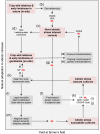Harnessing Crop Wild Diversity for Climate Change Adaptation
- PMID: 34065368
- PMCID: PMC8161384
- DOI: 10.3390/genes12050783
Harnessing Crop Wild Diversity for Climate Change Adaptation
Abstract
Warming and drought are reducing global crop production with a potential to substantially worsen global malnutrition. As with the green revolution in the last century, plant genetics may offer concrete opportunities to increase yield and crop adaptability. However, the rate at which the threat is happening requires powering new strategies in order to meet the global food demand. In this review, we highlight major recent 'big data' developments from both empirical and theoretical genomics that may speed up the identification, conservation, and breeding of exotic and elite crop varieties with the potential to feed humans. We first emphasize the major bottlenecks to capture and utilize novel sources of variation in abiotic stress (i.e., heat and drought) tolerance. We argue that adaptation of crop wild relatives to dry environments could be informative on how plant phenotypes may react to a drier climate because natural selection has already tested more options than humans ever will. Because isolated pockets of cryptic diversity may still persist in remote semi-arid regions, we encourage new habitat-based population-guided collections for genebanks. We continue discussing how to systematically study abiotic stress tolerance in these crop collections of wild and landraces using geo-referencing and extensive environmental data. By uncovering the genes that underlie the tolerance adaptive trait, natural variation has the potential to be introgressed into elite cultivars. However, unlocking adaptive genetic variation hidden in related wild species and early landraces remains a major challenge for complex traits that, as abiotic stress tolerance, are polygenic (i.e., regulated by many low-effect genes). Therefore, we finish prospecting modern analytical approaches that will serve to overcome this issue. Concretely, genomic prediction, machine learning, and multi-trait gene editing, all offer innovative alternatives to speed up more accurate pre- and breeding efforts toward the increase in crop adaptability and yield, while matching future global food demands in the face of increased heat and drought. In order for these 'big data' approaches to succeed, we advocate for a trans-disciplinary approach with open-source data and long-term funding. The recent developments and perspectives discussed throughout this review ultimately aim to contribute to increased crop adaptability and yield in the face of heat waves and drought events.
Keywords: abiotic stress tolerance; ex situ conservation; genebanks; genetic adaptation; genome-wide selection scans (GWSS); genome–environment associations (GEA); genomic prediction (GP); germplasm collections; machine learning (ML).
Conflict of interest statement
The authors declare no conflict of interest.
Figures


Similar articles
-
Genome-Environment Associations, an Innovative Tool for Studying Heritable Evolutionary Adaptation in Orphan Crops and Wild Relatives.Front Genet. 2022 Aug 5;13:910386. doi: 10.3389/fgene.2022.910386. eCollection 2022. Front Genet. 2022. PMID: 35991553 Free PMC article. Review.
-
Assessing and Exploiting Functional Diversity in Germplasm Pools to Enhance Abiotic Stress Adaptation and Yield in Cereals and Food Legumes.Front Plant Sci. 2017 Aug 29;8:1461. doi: 10.3389/fpls.2017.01461. eCollection 2017. Front Plant Sci. 2017. PMID: 28900432 Free PMC article. Review.
-
Epigenomics in stress tolerance of plants under the climate change.Mol Biol Rep. 2023 Jul;50(7):6201-6216. doi: 10.1007/s11033-023-08539-6. Epub 2023 Jun 9. Mol Biol Rep. 2023. PMID: 37294468 Review.
-
Enhancement of Plant Productivity in the Post-Genomics Era.Curr Genomics. 2016 Aug;17(4):295-6. doi: 10.2174/138920291704160607182507. Curr Genomics. 2016. PMID: 27499678 Free PMC article.
-
Crop adaptation to climate change: An evolutionary perspective.Mol Plant. 2023 Oct 2;16(10):1518-1546. doi: 10.1016/j.molp.2023.07.011. Epub 2023 Jul 27. Mol Plant. 2023. PMID: 37515323 Review.
Cited by
-
Overexpression of Terpenoid Biosynthesis Genes Modifies Root Growth and Nodulation in Soybean (Glycine max).Cells. 2022 Aug 23;11(17):2622. doi: 10.3390/cells11172622. Cells. 2022. PMID: 36078031 Free PMC article.
-
Genome-Environment Associations, an Innovative Tool for Studying Heritable Evolutionary Adaptation in Orphan Crops and Wild Relatives.Front Genet. 2022 Aug 5;13:910386. doi: 10.3389/fgene.2022.910386. eCollection 2022. Front Genet. 2022. PMID: 35991553 Free PMC article. Review.
-
Phylogenomic and Microsynteny Analysis Provides Evidence of Genome Arrangements of High-Affinity Nitrate Transporter Gene Families of Plants.Int J Mol Sci. 2021 Dec 3;22(23):13036. doi: 10.3390/ijms222313036. Int J Mol Sci. 2021. PMID: 34884876 Free PMC article.
-
Identification of QTLs and Putative Candidate Genes for Plant Architecture of Lotus Revealed by Regional Association Mapping.Plants (Basel). 2023 Mar 8;12(6):1221. doi: 10.3390/plants12061221. Plants (Basel). 2023. PMID: 36986910 Free PMC article.
-
Abiotic Stress Tolerance Boosted by Genetic Diversity in Plants.Int J Mol Sci. 2024 May 14;25(10):5367. doi: 10.3390/ijms25105367. Int J Mol Sci. 2024. PMID: 38791404 Free PMC article.
References
-
- Tai A.P.K., Martin M.V., Heald C.L. Threat to future global food security from climate change and ozone air pollution. Nat. Clim. Chang. 2014;4:817–821. doi: 10.1038/nclimate2317. - DOI
-
- Davis K.F., Gephart J.A., Emery K.A., Leach A.M., Galloway J.N., D’Odorico P. Meeting future food demand with current agricultural resources. Glob. Environ. Chang. 2016;39:125–132. doi: 10.1016/j.gloenvcha.2016.05.004. - DOI
-
- Borelli T., Hunter D., Powell B., Ulian T., Mattana E., Termote C., Pawera L., Beltrame D., Penafiel D., Tan A., et al. Born to Eat Wild: An Integrated Conservation Approach to Secure Wild Food Plants for Food Security and Nutrition. Plants. 2020;9:1299. doi: 10.3390/plants9101299. - DOI - PMC - PubMed
Publication types
MeSH terms
LinkOut - more resources
Full Text Sources
Medical
Research Materials

